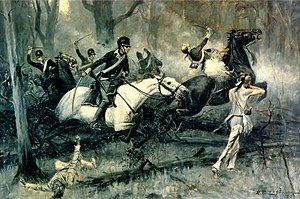Battle of Fallen Timbers
| Battle of Fallen Timbers | |||||||
|---|---|---|---|---|---|---|---|
| Part of the Northwest Indian War | |||||||
 An 1896 depiction of the battle from Harper's Magazine. |
|||||||
|
|||||||
| Belligerents | |||||||
|
|
|||||||
| Commanders and leaders | |||||||
|
|
Blue Jacket Buckongahelas |
||||||
| Strength | |||||||
| 2,000 (including native scouts) |
2,000 (including 1 British company) |
||||||
| Casualties and losses | |||||||
| 33 killed 100 wounded |
25–40 killed Unknown wounded |
||||||
Western Confederacy![]() Great Britain
Great Britain
The Battle of Fallen Timbers (August 20, 1794) was the final battle of the Northwest Indian War, a struggle between Native American tribes affiliated with the Western Confederacy, including support from the British led by Captain Alexander McKillop, against the United States for control of the Northwest Territory (an area north of the Ohio River, east of the Mississippi River, and southwest of the Great Lakes). This land had been ceded to the United States in accordance with the Treaty of Paris (1783), but the British and Indians (who had not been party to the treaty) refused to comply with the treaty and relinquish control. British army bases were maintained there to support their Native allies. This ultimately led to the American offensive and subsequent British-Indian withdrawal from the territory altogether following the Treaty of Greenville. The battle, which was a decisive victory for the United States, ended major hostilities in the region until Tecumseh's War and the Battle of Tippecanoe in 1811.
The Ohio River boundary line established by Britain in the 1768 Treaty of Fort Stanwix recognized certain lands as belonging to the Native American nations. After the American Revolution, however, the United States government maintained the Native American nations no longer owned the Ohio lands, since in an article in the Treaty of Paris of 1783 Britain agreed to cede to the United States the lands owned by the indigenous nations. The Native Americans involved rejected the idea of the British or Americans to dispose of their tribal lands without their consent. They had no representation at the Paris Treaty negotiations, had not signed the treaty, and refused recognize the British give-away of their land. As American settlers began moving into the Ohio Country, the Native Americans viewed them as unwelcome intruders. The United States government, on the other hand, insisted it had the right to occupy the lands, since it had been gained in battle and was agreed to by the treaty with Britain.
...
Wikipedia
